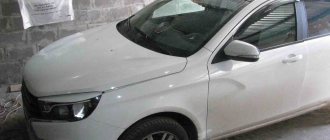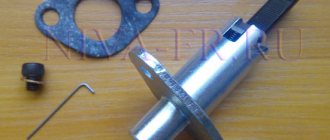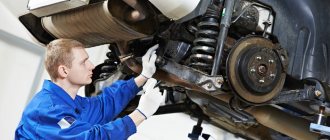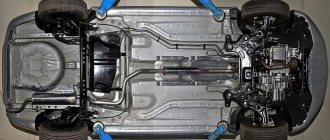After the presentation of the concept version of the Lada Vesta car, many domestic car enthusiasts were looking forward to the start of mass production of the model. Already in mid-2015, the first lucky people got a brand new city sedan. According to statistics, Vesta is by far the most popular Russian car. Car sales are steadily growing from year to year thanks to the correct development strategy of AvtoVAZ. In the model range, Lada Vesta replaced Lada Priora, surpassed Lada Granta and Kalina in terms of the number of units sold, coming very close to its main competitor - Kia Rio. The share of Russian spare parts is about 20%, the rest is borrowed from imported cars. Since AvtoVAZ has become an integral part of the Renault-Nissan concern, Lada Vesta adopted many components and assemblies from French Renault cars. The line of power units includes two Russian engines and one French one – HR16DE. Despite its popularity, the shortcomings and disadvantages of the Lada Vesta force potential buyers to pay attention to other cars. In this article, we will try to find out how serious mistakes AvtoVAZ engineers made during the design of the car.
Car body
A detailed review of the weak points of the model should start with the exterior and interior. Most car owners have absolutely no complaints about the appearance of the car. The car really turned out to be attractive and in line with modern trends in vehicle design. Over the long period of production of AvtoVAZ products, you can safely rank the words “beautiful Lada” without falling under the grins of acquaintances and friends. Contrary to popular belief that the VAZ quickly rusts, the new sedan has a galvanized body that quite successfully copes with all the hardships of operation in difficult conditions. The disadvantages of the Lada Vesta in terms of bodywork come down to the quality of the paintwork. Over time, chips and scratches appear on body elements, especially on the front bumper, which in theory can develop into something more serious.
When examining the car, you involuntarily pay attention to the windshield wipers. Experienced motorists remember the old saying: “If you buy a VAZ, change your wipers right away.” In Vesta the problem is not radical, but in some cases it can cause big problems, for example, scratching the glass. But such a nuisance is an isolated incident. Windshield wipers are noisy - they creak, knock and click. After replacing the factory mechanisms, you begin to understand that any other “wipers” work much better than the “stock” ones. Another common problem that, judging by the reviews, annoys all Lada Vesta car owners is the tight fit of the velvet covers to the side windows. That is, using power windows, you can scratch the glass if, for example, sand gets in there.
Anticorrosion problems
There is an opinion that the internal cavities of the body are not treated very thoroughly with anticorrosive. This means that rust may settle there over time. But it will be possible to check this no earlier than in 3-4 years. Let's assume that there won't be any rusty spots for a long time.
Wax compounds used to treat the internal cavities are responsible for the anti-corrosion protection of thresholds, pillars and side members. In turn, body reinforcements and external panels, with the exception of the roof, require double-sided galvanization. The underbody is protected with proven bitumen-based mastic. Only she is not afraid of aggressive reagents.
Lada Vesta salon
We move smoothly from the body to the interior design of the sedan. Once inside the car, you immediately notice that the plastic is not of the highest quality and is durable, of which there is an abundance inside. If the car already has a mileage of 15-20 thousand kilometers, then at times you can hear creaks and crickets of component parts, which indicates that the quality of the seals is not high enough. Also, in their reviews, car owners often complain about the steering wheel pad - it quickly wears out and loses its original appearance.
Read The Audi SQ2 crossover from ABT has significantly increased its output
Of course, making complaints about the quality of finishing materials in the interior of a car, the price tag of which barely exceeds the mark of 500,000 rubles, is a thankless task. You won’t find Alcantara or leather inside (although eco-leather is available in the top-end configuration). The most serious “disease” of the Lada Vesta in the cabin is multimedia. Owners complain en masse about “glitches” and system freezes; often the radio does not turn on at all - only a “hard reset” helps.
The rest of the owners' complaints about the interior boil down to the following:
- the instrument panel is not well detailed - the indicators of some sensors are not so easy to read, you have to peer at them, which at times interferes with driving;
- the view of additional instruments is completely obstructed by the steering wheel;
- The CityGuide navigation system does not work correctly (over time, the manufacturer eliminated this problem).
When you connect a phone or after switching to the “AUX” mode in the menu, the rear view camera often stops working and Bluetooth turns off spontaneously. But with all this, we note that all these shortcomings were clearly noticeable even in the first batches of the car. In addition, glitches can be eliminated by changing the firmware. In all other respects, the interior of the Lada Vesta can be given a positive assessment of the level of comfort: comfortable seats, an armrest for the driver and a steering wheel.
Body problems
But, of course, this car cannot be idealized. For example, you need to periodically adjust the fit of the trunk lid. Otherwise, over time, it will hit the bumper, and the peeling edge will become a place for corrosion to appear.
Water may get into the turn signals located on the mirror housings. If previously you had to buy entire mirrors for treatment, now lighting equipment is sold separately. And one more thing - remember that the hood must be closed with one clap. If you press the lid with your hands, dents may remain on it.
The list of body problems is completed by a peeling emblem and a trunk lock cylinder that can jump out of its seat.
Disadvantages of the Lada Vesta chassis
The domestic sedan is not without shortcomings in the chassis. Most often, the stabilizer struts were the first to fail. The problem plagued the owner of the first batch of serial production Lada Vesta. As a rule, after 3-5 thousand kilometers the struts required replacement, as they worsened the car’s handling and became sources of increased noise from the suspension. Following the struts, the stabilizer rubber bands began to act up: the rubber seals creaked when in contact with smooth metal. The creaks were eliminated by treating the metal with sandpaper; AvtoVAZ explained the presence of the “disease” by cooperation with a less than conscientious supplier, whom the concern’s management promised to replace soon.
Car owners had to tinker with ball joints at the very beginning of owning a car. Already after 30-40 thousand kilometers, play may appear in the lower bearings of the steering cam. This period of support life is considered below the statistical average. Often the problem made itself felt even on cars under warranty. There is only one solution in such a situation - replacing the entire lever assembly, since it is not possible to fix the breakdown in any other way. “Stock” alloy wheels cannot boast of strength and reliability; they are popularly called “paper” due to deformation after the wheel gets into even a minor road hole.
Box robot AMT
The robotic transmission was created from the same five-speed gearbox, to which ZF actuators were added. This is a very primitive robot with one clutch.
If for the light Priora, Granta or Kalina the AMT turned out to be a very real alternative to the classic automatic, then for the large Vesta the VAZ development was not the most suitable acquisition. In any case, only the lazy did not scold her for jerks and kicks during switching.
Gear shifts began to change more or less well when AvtoVAZ introduced firmware 2.0. Shifts are a third faster.
In addition, new modes have appeared:
- Creeping, when you can start moving without pressing the gas pedal, but simply releasing the brake.
- Winter, when the start occurs immediately from second gear.
Cars produced before the summer of 2021 will have old firmware, and it must be replaced with a new one. The software called 3.0 is a product of third-party manufacturers and has nothing to do with AvtoVAZ.
This robot, which did not cause a barrage of criticism on Priora and Grant, became the cause of a large number of negative reviews on Vesta. Partly due to the greater weight of the car, and also because the car was usually bought by residents of large cities. In traffic jams, it turned out that the clutch can quickly overheat, and as a result wear out.
Moreover, this can happen in just 20-30 thousand kilometers. If the time has come to replace the disk, then instead of the standard Valeo it is better to install a Sachs product. And that's not all the trouble.
In the first editions of the Vesta sedan, actuators were often changed due to too noisy operation. In 2021, ZF brand products began to literally burn at work due to poor-quality connectors. In addition, it turned out that the robot does not like extremely low temperatures. The car may not start, and if the engine does start, the car will only drive in 3rd gear.
Problems with the Lada Vesta robot
As for the transmission, the most problematic and at the same time discussed component of the sedan was the robotic gearbox. Mechanical enthusiasts haven’t even considered the version of the car with a “robot,” but fans of automatic transmissions have already managed to actually try out the innovative unit. The disadvantages and disadvantages of the Lada Vesta are twitching, long gear shifts and incomprehensible algorithms for the operation of the gearbox. By the way, ordinary car enthusiasts, along with critics, disliked AMT from the very first days. This gearbox requires a special approach and care. In addition, it takes time to adjust and get a feel for the “robot”, and to adapt your driving style to it. However, many AMT errors can be eliminated by “reflashing” them from the officials.
Read Toyota electric cars will be produced in Indonesia
The well-known manual transmission made it clear from the first days that it retained the title of the most reliable, stable type of gearbox. Only a few reviews from car owners indicate early mechanical failure: the bearings can “howl” and the first three gears begin to engage with difficulty. Usually the first serious difficulties appeared after 20-25 thousand kilometers.
Transmission, engine and its systems
- No breakdowns of the VAZ-21129 engine (1.6 l, 106 hp) were recorded during the entire period of endurance testing. The power unit was serviced according to technical regulations.
- The fastenings of the decorative engine cover broke several times (see How to modify the engine cover).
- A slight chafing of the hose by the plastic cover of the engine was noticed (see What to do if hoses/pipes under the hood chafe).
- The heater radiator leaked.
- The muffler burned out.
- All muffler cushions (gingerbread) were torn 2 times.
- After 15,000 kilometers, 1st, 2nd and 3rd gears began to resist and were difficult to engage (the rod blocking block was stuck in its hole). Towards the end of the tests, the manual gearbox from Renault (JH3) began to howl with bearings, and it had to be repaired.
Exhaust system
Lada Vesta inherited from the VAZ-2108 and 2109 the “disease” of the exhaust system - sagging rubber bands on the muffler mounts. Owners of domestic cars claim that after 30 thousand kilometers you can hear the characteristic sound of the muffler beating against the tunnel - a sure sign of wear on the rubber elements. In rare cases, the exhaust system resonator burns out - a lifespan of about 80,000 kilometers. You can often hear from drivers how the noise of the Lada Vesta exhaust system interferes with driving. Official representatives of AvtoVAZ even gave clarifications on this matter. The thing is that both at high and low speeds, a hum, whistle and other unpleasant sounds from the muffler may appear. It may seem that the corrugation simply does not suppress the resulting vibrations. To which AvtoVAZ responded that the noise of the exhaust system is a problem for a specific car. If you encounter a similar problem, then you need to contact the dealership, where the dealer is required to fix the “jambs” under warranty.
About spare parts
- Prices from official dealers are not the same, but may differ several times. For example, a set of front brake pads can cost from 1,500 to 3,800 rubles at different dealers.
- The most expensive spare part was the muffler - 11,000 rubles.
- Almost all spare parts for Vesta have to be purchased to order and wait on average 1 month.
Show/Hide text
| Costs for a Lada Vesta car | ||
| Mileage, km | What was spent on | Amount, rub. |
| 3500 | Wheel cap | 100 |
| 6375 | Brake pads | 2420 |
| 7930 | Exhaust system mounting support | 50 |
| 10020 | Exhaust system mounting support | 50 |
| 10020 | Brake pads | 1950 |
| 10100 | Wheel cap | 100 |
| 11790 | TO-1 (oil, oil filter) | 2800 |
| 12580 | Engine plastic cover retainer | 110 |
| 15850 | Brake pads | 1950 |
| 16260 | Wheel cap | 100 |
| 18320 | Exhaust pipe | 11300 |
| 20300 | Exhaust system mounting support | 50 |
| 23250 | Muffler suspension | 200 |
| 23750 | TO-2 (oil, oil, air, cabin filters, spark plugs) | 5500 |
| 25520 | Rear shock absorber | 3100 |
| 25600 | Antenna | 4500 |
| 26000 | Rear shock absorber | 3100 |
| 26800 | Rear suspension beam silent blocks | 1220 |
| 27600 | Brake pads | 1950 |
| 30300 | Wheel cap | 100 |
| 31200 | Wheel cap | 100 |
| 31500 | Heater radiator (complete with heater) | 19000 |
| 31800 | Release bearing | 4450 |
| 31800 | Secondary shaft bearing | 1450 |
| Topping up engine oil (for the entire period) | 320 | |
| Total for maintenance and repairs | 67920 | |
| other expenses | Tires (4 sets) | 44000 |
| Gasoline AI-95 (average consumption 12.3 l/100 km) | 145630 | |
| Total expenses | 257550 | |
What is the result: Vesta or a Korean car?
These, in principle, are all the main “childhood” diseases of the domestic sedan. Yes, the car is still crude, some may think that 520-700 thousand rubles for a car with such shortcomings is too expensive. Note that in the review of the shortcomings of the Lada Vesta, the topic of engines was not touched upon. And all because the car is equipped with fairly reliable, and most importantly, time-tested power units. In addition, Vesta’s main competitors, Kia Rio and Solaris, also have their own shortcomings, which the manufacturer has not sought to eliminate for a long time. Due to the reasonable cost and variety of trim levels, the popularity of the Russian sedan in the domestic market is growing.
In terms of the price of component parts, it will not be possible to detect a serious price difference. Spare parts for these two cars cost the same, plus or minus. For example, replacing a damaged front door will cost the owner of a domestic car 18 thousand rubles, and the owner of a Korean sedan will cost 21 thousand. The price for a Lada Vesta catalytic converter varies from 15 to 18 thousand rubles, while for a “Korean” it is around 35-38 thousand rubles. What is better and which car to buy is up to everyone to decide.
Results
According to experts from the auto magazine, Vesta behaved much better during endurance tests than expected. It is worth considering that the car came from the first production batch, and this is associated with many minor shortcomings and shortcomings. In her class, Vesta can be called a source of pride.
More details in the video:
Let us remind you that according to reviews from owners, squeaks and rattles may appear in the Vesta’s cabin (see how to eliminate it). And to extend the service life of the cabin filter, install a protective mesh on the air intake.
Keywords: Lada Vesta engine | roof of Lada Vesta | trunk of Lada Vesta | bumper Lada Vesta | side mirrors of Lada Vesta | cooling system for Lada Vesta | rear suspension of Lada Vesta | exhaust system for Lada Vesta | Lada Vesta brakes
+2
Share on social networks:
Found an error? Select it and press Ctrl+Enter..
Steering
There are no complaints about the steering. But the electric booster has a progressive characteristic, that is, at low speeds the steering wheel rotates easily, and during acceleration the force increases. Some owners are unhappy with this, but this is a matter of taste. For example, I am quite happy with it.
I bought a Lada Vesta instead of a Japanese one
But the fact that AvtoVAZ did not release steering ends to the market until 2021 is a huge miscalculation. People were offered to buy the entire steering rack.
Peculiarities
The exhaust pipe is thin, the connecting clamp is of the old type. There is no tip on the muffler. The rear wheels have not only camber, but also toe. On Grants there was only collapse. The distance from the wheel to the wheel arch is different. All foreign cars have wheels located evenly in the arches. The seats in the cabin are height adjustable.
The steering wheel is reach adjustable. Cable gearbox. The clutch is hydraulic. The interior door handle must be made of the same color. The fuse compartment has braided wires so that nothing squeaks. The trunk opens with a button. Everything is done with high quality.
There is a regular air conditioner here, although the Priors had climate control. The seats are comfortable, the armrest is also comfortable. The rear seats have their own shape, rather than just flat benches. Child seats are fixed. The car in the back is spacious. The front seat backs raise and lower quickly using a lever.
There are questions regarding assembly. A sponge about a centimeter wide sticks out across the entire width of the panel. It may protect against squeaks, but it could have been hidden. All doors close clearly and smoothly. The ignition key is a flip key, like in foreign cars. But there is only one such key.
The second key is ordinary, without buttons. Our car is a luxury car without a monitor or multimedia. We consider this to be the most successful configuration, but the Lada Vesta has its advantages and disadvantages. There are mechanics here, not a slow robot. Of course, you don’t have to buy it, but why make it like that? And the box on it is VAZ, not a brand new one. The ergonomics in the car are very cool.
Engine compartment
Here you can note the wiring that is carried out openly, without protection. Also, the coils themselves quickly fail. I recently had one replaced under warranty.
The washer reservoir is noisy when there is some fluid left in it. It starts to gurgle, you can hear it in the cabin, the problem has not been fixed.
The hood often knocks, you have to constantly adjust it. Sometimes the limit switches freeze and the light comes on in the cabin. The electronics “think” the hood is open.
Causes of robot malfunctions
Electric motors are located at the location of the gear shift mechanism, as well as at the end of the clutch fork. In winter, condensation settles on the actuators, which simply freezes.
By the way, the cost of the actuators is more than 50 thousand rubles.
Therefore, decide for yourself whether to buy such a gearbox or whether it is better to go with a manual one.
Another interesting transmission of the Lada Vesta was the Japanese CVT, which created a lot of noise among car enthusiasts. Therefore, it is worth considering separately.
Other subtleties and troubles of Vesta at the beginning of operation
The Vesta owner will notice several more troubles right from the cabin that cause some discomfort. It must be remembered that the company seriously saved on electronic equipment, so the concern did not try to provide sufficiently high-quality options for alarms, security modules and sensors - we have already talked about this. But such troubles lead to other problems. Among the minor shortcomings of Vesta, the owners highlight the following features:
- it is impossible to open the trunk lid from the key fob, there is no reaction to pressing, in fact, you need to press it with a delay of a few seconds, then the trunk will open;
- the armrest is not fixed - many will be more grateful for the very fact of having a stylish armrest in a budget segment car, but you can still fix it, you need to very slowly lower it into the desired position;
- Steering on the highway is all about you trying to find a rut and stay in your lane - it is, but this is a budget car, not an incredible sports car;
- on a city trip you can’t hear the engine at all, but the wheels on studded tires simply don’t allow you to listen to music - you’ll have to install additional sound insulation;
- Consumption in the urban cycle turns out to be slightly higher than the manufacturer's promises; the car has encountered certain problems with traffic jams and downtime.
All these shortcomings can be written off as design features of a budget car. But they cause some discomfort to the vehicle owner. Of course, you can choose a car that simply does not have all these troubles, but it will cost much more than the Lada Vesta. In addition, this is the first time that a Russian car of this class has come out from under the wing of the concern, so you can forgive a certain number of shortcomings and hope for a successful continuation of the work begun. We invite you to watch a short video about Lada Vesta repairs from a reputable automotive publication:
Suspension
What Lada cars have always been famous for is their omnivorous suspension. Vesta was no exception, although, as they say, Moscow was not built right away. For example, at first, when turning the steering wheel in the rain, an unpleasant squeaking sound occurred. It was cured by installing new front spring mounts. Instead of knocking front stabilizer struts, new ones appeared.
The rubber cushions on the upper brackets of the rear shock absorbers have become softer. In addition, AvtoVAZ swears that it has long ago solved the problem of squeaking stabilizer bar bushings. This saved the car from unpleasant sounds during large suspension moves. For this purpose, imported German stabilizers with vulcanized bushings are now installed.
Children's engine sores
Lada Vesta is a Russian car, people usually listen to it and sniff it.
DETAILS: Common faults on the VAZ 2110 2111 2112 Main weaknesses and frequent breakdowns of Ladas of the tenth family in infographics
Many car enthusiasts are alarmed by the sound of the engine
Which migrated to the Lada Vesta from the Lada Kalina, Lada Granta and Priora. This 16 valve engine with a capacity of 106 horsepower was installed on many AvtoVAZ models. For the Lada Vesta, a similar engine is available in a modernized form. It does not have a large list of significant alterations, although it is worth noting that it is adapted to Euro 5 standards.
The engine, due to its environmental friendliness, has become sensitive to fuel quality. You should not experiment with questionable fuel as there have been precedents when problems with valves arose. Disassembly of the engine shows that low-quality fuel simply cannot be digested, which causes big problems with valve sticking and scuffing.
— there are more and more complaints about unstable idling;
— revolutions float;
Why, you ask, is there such a long break between posts? There are two reasons. The first - the red-haired Vesta went, as they say, from one hand to another: the editorial staff need to formulate their opinions about the next new product from AvtoVAZ?! And secondly, on the eve of the New Year holidays, almost all of us had more important things to do than driving a car. Lada apparently didn’t like this, so very soon our editor-in-chief Dmitry Krotov called me with “good” news: the “anti-freeze” is leaking! As they say, Happy New Year!
Rear washer operation and anti-freeze leakage:
The anti-freeze leak, fortunately, turned out to be connected not with the front, but with the rear wiper: when the rear window washer was turned on, a very modest stream sprayed from the nozzle. And from under the front right door seal, a characteristic blue puddle with a peach aroma appeared on the asphalt and on the carpet in the cabin. Therefore, as soon as the car was back in my hands, I made an appointment with the dealer for service again. True, this time to another division of Tekhinkom - closer to home (in the first division, as we remember, half of the problems were never solved...).
While the front right door is closed, most of the “anti-freeze” flows down behind the fender, and then onto the asphalt. But as soon as the door opens, the entire flow of alcohol-containing liquid flows into the interior onto the carpet
By the way, this leak is not the only problem of our Vesta Cross that was voiced to the dealer. Over the four thousand kilometers traveled by that time, the car’s handbrake “stretched out” (in order to securely fix the car in the parking lot, the lever had to be raised at least 7-8 clicks, almost resting against the end of the central armrest box) and still The front wipers jerked upward at the end of their stroke. Added to this was the key fob, whose switch blade began to jam in the folded position.
Trying to “open” the key on Vesta Cross:
The flickering of the on-board computer display on the dashboard did not go away when setting up some functions. However, on this issue we are still waiting for a response from our “native” dealer, who sent a corresponding request to the factory, so this problem was not raised this time. But the attentive master receiver found another:
A standard check of the engine oil level showed a low level - even just below the lower mark. To be honest, this came as a surprise to me, because although I had heard about oil burn on 1.8-liter VAZ engines for Vesta and XRay, I did not expect its manifestation after only four thousand kilometers.
After the technical wash, just five minutes later the technician found the cause of the anti-freeze leak. Those who were ready to “throw” another portion of brown on the fan of AvtoVAZ criticism can go and rest, because the reason turned out to be a broken tube going to the rear washer through the roof pillar. During installation of the recorder's wiring, it fell under the fastening piston of the internal decorative trim and after some time, as expected, was torn by it. This is all the more surprising and annoying because the rubber tube under the lining has special fastenings and should not dangle when it gets under the pistons. Most likely, the “human factor” manifested itself here in the form of an oversight when installing the cover after laying the power cable of the recorder.
And here is the place of the leak. Because of this, changing the entire tube is time-consuming and expensive: it’s easier to completely cut it at the break point and connect it using a 20-ruble plastic fitting
Tightening the handbrake also did not cause any difficulties (it remains to be seen whether the problem will recur...). Along the way (at our request), we were connected to power for the GPS tracker. But the twitching of the wipers was not corrected this time either. “I wouldn’t recommend doing this, so as not to damage the fasteners of the windshield wipers and subsequently lose the warranty because of this...” - to be honest, coming from the mouth of a master at an official dealer service center, this reason sounds a little strange, don’t you think? It turns out that it is better not to fix other minor breakdowns, so as not to lose the warranty?
Since the DC sells oils from Lukoil under a proprietary brand, and our car was filled with Rosneft oil from the factory, it was decided to use the latter for topping up. Moreover, the plant officially still recommends using Rosneft Maximum with a viscosity of 5W-40 or 10W-40. The required oil was found at the nearest Rosneft gas station.
The jamming of the key “sting” in the key fob was also not eliminated. It is possible that this happened due to the fact that I reported this problem after placing the work order. Without being written down on paper, the problem was simply “lost” (at the same time, the car was given out with the key in the lock, so I also missed this point when accepting the car).
More about oil. Fans of domestic motorsport know that the official partner of Lada is Rosneft, in whose colors - with a predominance of yellow - the cars of the factory circuit racing team are painted. However, the oils sold in dealership centers under the Lada brand have nothing to do with Rosneft, and their manufacturer can be easily guessed by the characteristic shape of the canisters...
Of course, when buying, albeit a Lada, but still the most modern and expensive one, you want to forget about an unscheduled service visit, at least for the duration of the warranty. And if the leakage of the antifreeze is entirely our fault, then everything else... Well, the handbrake cable shouldn’t stretch out after three thousand kilometers! And adding half a liter of motor oil (even relatively inexpensive, domestic) every three to four thousand kilometers is also not appropriate for a new engine without any technological delights. But the questions for the new station wagon do not end there: in the near future you will have to go to the dealer again and find out the cause of the knocking under the bottom during slippage. It feels like the exhaust system is poorly secured. But it is not a fact that this is the reason. So to be continued!
Best regards, Alexey A_ST
And a little more about “quality”: this is what the “original” window deflectors for Vesta SW look like (we apologize for the quality of the photo - we took it with what we had on hand)... We, of course, understand everything, but when two parts simply don’t match sizes should be the same... 
And now we will answer some questions from our readers, asked in a special form (the authors’ style has been preserved). Let’s say right away: this time we are not answering all of them: for some we will try to make an official request to the plant. For others, it is necessary to carry out additional measurements and tests. But in any case, we will try not to leave your curiosity unattended! So, let's go!
Questions from Vesta SV Cross blog readers and answers from Droma test drivers
— I bought Vesta Cross 1.6. What gearbox is it? (M)
On the Cross modification with a 1.6-liter engine, only a manual transmission developed by AvtoVAZ is installed.
— Which manual transmission is better: the Russian one, which comes with a 1.6 engine, or the French one, which comes with a 1.8 engine? In terms of noise and clarity of switching. (Michael)
It is generally accepted that the domestic gearbox is noisier. However, during the first tests we tested three different Vesta SW and SW Cross station wagons with French gearboxes. And on all the machines, slight but still audible “howls” were noted, previously characteristic exclusively of domestic gearboxes. At the same time, our editorial car with a robotic transmission, which is based on a domestic gearbox, was not noticed with such noise. As for the clarity of switching, here too the domestic transmission, in our opinion, “looks” a little better than the imported one.
— Is it possible to coast downhill on an AMT at a speed of 60–80 km/h in selector position N? (Stanislav)
Theoretically this is possible. The question is: why? This is unsafe in terms of maintaining control of the vehicle. And you won’t get any fuel savings if you don’t turn off the engine. One way or another, this action is not spelled out in the operating instructions.
— Do these cars have 4WD automatic? (Renat)
Unfortunately, there are no such modifications and are not expected in the near future.
— Why such a critical attitude towards the “robot”? Is the “robot” on a Honda Civic or Opel Astra much better, in your opinion? P.S. My friend has an Astra 1.6 on a “robot”, I have a Civic 1.8 on a “robot”. (Ilya)
Indeed, almost all of the editorial staff have a negative attitude towards the “robot” on Vesta, and this negative is directly dependent on the degree of activity when driving a car in everyday life. However, there is an opinion from authoritative racer Arkady Tsaregradtsev that Vesta’s “robot” is still at least no worse than those of foreign models in the mass segment.
— 1.8 engine — whose development? "AvtoVAZ" or does it have something to do with the 1.8 Nissan engine? (Sergey)
We talked in more detail about the VAZ-21179 engine here. Its technical characteristics can be viewed in our catalog.
— Do the mirrors fold in the opposite direction? (Efim)
Yes, they add up. But they are not fixed in this position.
— Is there air conditioning? (Andrey)
Yes, all Vesta SW station wagons are already equipped with air conditioning in the basic versions, and SW Cross is also equipped with a climate control system.
— How do you turn off the climate control on it? For example, on the Rio there is an OFF button, but on the Vesta there is NOT one, since it turns off - we just turn off the car or do we need to turn the fan to zero? Is the plastic body kit not peeling off? Floating roof - how are these linings secured? (Sergey)
Pressing the AUTO key again does not disable the automatic climate control mode: you can change the operating mode only by pressing other buttons for selecting the blowing mode or rotating the adjustment dials. Complete shutdown of the system is only possible by reducing the fan speed to zero. Regarding the body kit, we think it’s too early to draw conclusions - too little time has passed (although we haven’t heard about problems with decorative plastic on cross-versions, for example, Largus). As for the “floating roof” overlays, you can see their fastening in the photo (two metal bolts per overlay, two more bolts on each side holding the spoiler).
— Is it possible to arrange a sleeping place for two people in the car? (frequent trips across the seas, wife and child spend the night in the car)… Is the cabin suitable for family travel for a family of three or four people to relax as savages with a huge “pile” of things? (the question is more about the size of the trunk and interior)… (Evgeniy, Vladivostok)
It all depends on what conditions you are used to. It happens that they spend the night in sedans, without folding out the front seats, while others feel uncomfortable in specially designed campervans. The same applies to the suitability of the cabin for family travel: a lot depends on the amount of luggage, requirements for additional amenities, the height of passengers and even the geography of the trip... In our opinion, all this is too individual to give clear recommendations. One way or another, you can get an idea of the possibility of sleeping overnight with the rear sofa folded down in the photo below.
— I’m very interested in how the rear sofa folds, how far it folds into the floor, is it possible to then lie down in the car at full height (185 cm)? Thanks in advance (Igor)
Here you can also evaluate everything from our photographs above, as well as in comparative tests of the West station wagon with its competitors. For example, here).
— Did the designers provide space and fasteners for a fire extinguisher in the car? It’s not in a motorist’s kit to carry it! The fire extinguisher must be in an easily accessible place and always be ready to be quickly brought into “combat condition.” Approximately fire extinguisher OU-5 (its weight is approximately 13 kg) (Alexander)
Counter question: what modern mass-produced car, officially sold and having a standard place and fasteners for a five-liter (!!!) fire extinguisher, can you name as an example? We don't know such cars. Exceptions are sports cars and other specially prepared cars.
— Hello, where in the Khabarovsk Territory can Vesta be serviced so as not to lose the warranty? (Eugene)
Hello! In fact, no one has been making tin-plated bodies for a long time: nowadays galvanizing of steel external elements is in use.











